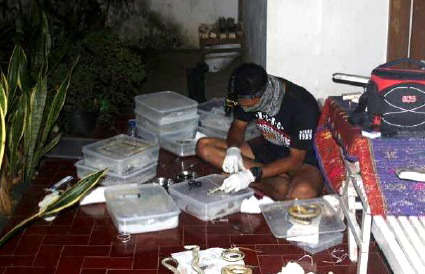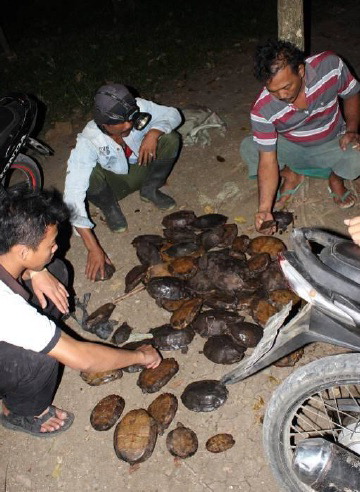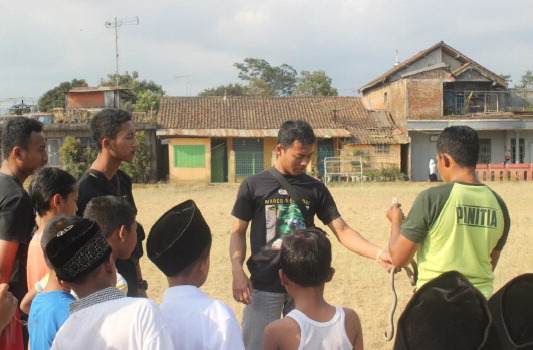|
Cycle 3 (2014 Deadline) Diversification and inventory of the threatened lowland herpetofauna of Java and Sumatra U.S. Partner: Eric Nelson Smith Urrutia, University of Texas at Arlington
Project Dates: November 2014 to April 2017
 | | A team member takes tissue samples and preserves sample organisms. |  | | Traders participate in a roaring amphibian trade in Turtle Bay. |  | | The team educates local children on snake handling and the importance of biodiversity (all photos courtesy of Dr. Kurniawan). |
Project OverviewWildlife harvesting is a thriving global phenomenon that has received substantial attention from conservation biologists and policy makers. Compounded by loss of natural habitats, climate change, and disease, human over-exploitation may lead to the decline and extinction of species. The harvesting of reptiles and amphibians from the wild is an especially relevant issue to the herpetofauna of Southeast Asia. The research team will seek to establish baseline population genetic data for species of lowland reptiles and amphibians of Sumatra and Java that are prevalent in the wild animal trade. Using molecular techniques, the team expects to achieve the following goals: (1) delimit the population boundaries of species common in the animal trade; (2) determine the population of origin of animals from the wildlife trade; (3) determine the relative impact of the wildlife trade on distinct populations of reptiles and amphibians; (4) establish a new molecular laboratory at the University of Brawijaya. This project will facilitate the genetic monitoring of samples collected from legal and illegal wildlife trade and will serve as a valuable tool for management of harvested populations. This research project will strongly compliment Dr. Eric Smith’s inventory of the highland herpetofauna of Java and Sumatra by focusing on the lowland taxa, and using his project’s biodiversity data will inform wildlife management practices and policies. Data generated by this project will help guide policies and practices that will ensure the long-term sustainability of the commercial and domestic harvest of Indonesian amphibians and reptiles. The project will provide valuable data to various stakeholders to aid in the selection and prioritization of harvestable species. This effort will include making available large DNA reference collections and large public databases comprised of allele frequencies from regularly harvested populations. The research study will greatly benefit Indonesian stakeholders, such as students, museum technicians and researchers, government officials, and local wildlife traders, all of whom will be integrated into the project. They will be trained in the field as well as museum work, computational and molecular biology, and will be encouraged to participate in local outreach programs, publications, and presentations at scientific meetings.
Final Summary of Project Activities
During field research trips to various locations in Java and Sumatra, the team also held discussions with traders and local residents about herpetofauna, changing mindsets about automatically killing snakes by explaining the ecological role of the animals, ways to handle snakes, and first aid for snakebite. The researchers also held workshops on herpetofauna diversity and the importance of sustainable harvest at senior high schools, reaching hundreds of students and residents. Grantees also presented their findings with other universities and institutions including two symposiums on Asian vertebrate species diversity.
Two members of the PEER funded research team traveled to the University of Texas at Arlington to meet the project’s U.S. partner and participate in an exchange program. At UTA, they learned new DNA extraction and analysis methods, specimen preservation techniques and how to produce anti-venom, and discussed an ongoing paper.
During the PEER grant period, the PI and colleagues established a new Herpetology course for undergraduates at Brawijaya University, and was awarded a $21,000 grant for a related proposal from the university. Researchers on this team published nine peer-reviewed papers as a result of the grant.
The research team collaborated with a wide range of organizations, including Remote Envenomation Consultancy Services, an organization that assists healthcare providers with information about snakebite management, via their data about snake diversity and distribution. They have also developed relationships through this project with Museum Zoologicum Bogoriense (MZB) at the Indonesian Institute of Sciences, the Indonesian Department of Environment and Forestry, Paru Dungus Hospital in Madiun, and Meru Betiri National Park.
This project also led to the initial planning stages of a Herpetofauna conservation center at Brawijaya University and an increase of students choosing herpetology as a thesis topic.
Publications
Harvey, M.B., Hamidy, A., Kurniawan, N., Shaney, K. & Smith, E.N. 2014. Three new species of Pseudocalotes (Squamata: Agamidae) from southern Sumatra, Indonesia. Zootaxa 3841 (2): 211-238.
Harvey, M.B., O'Connell, K.A., Barraza, G., Riyanto, A., Kurniawan, N. & Smith, E.N. 2015. Two new species of Cyrtodactylus (Squamata: Gekkonidae) from the Southern Bukit Barisan Range of Sumatra and an estimation of their phylogeny. Zootaxa 4020 (3): 495-516.
Harvey, M.B., O'Connell, K.A., Wostl, E., Riyanto, A., Kurniawan, N., Smith, E.N., & Grismer, L.L. 2016. Redescription Crytodactylus lateralis (Werner) (Squamata: Gekkonidaei) and Phylogeny of the Prehensile-tailed Cyrtodactylus. Zootaxa 4107 (4): 517-540.
Kurniawan, N., Fahmi, M., Priambodo, B. 2015. Phylogenetic relationship of the Genus Limnonectes (Amphibia, Anura) in Sundaland and surrounding areas as revealed by 12s rRNA, tRNA val and 16s rRNA sequence analysis. Proceeding of JSPS-Core-to-Core Program: The 5th International Symposium on Asian Vertebrate Species Diversity. Chulalongkorn University, Bangkok. December 14-19, 2015.
Kurniawan, N., Priambodo, B., Nugraha, F.A.D., Maulidi, A., Kurnianto, A.S. 2017. Microhabitat Assessment of Mangrove Pit Viper Cryptelytrops purpureomaculatus in Restricted Mangrove Area, Dumai, Riau Province, Sumatera. The Journal of Tropical Life Science 7(2): 91-94.
Riyanto, A., Sidik, I., Fauzi, M.A., & Kurniawan, N. 2016. A New Bent-Toad Gekko of the Genus Cyrtodactylus Gray, 1827 (Reptilia, Gekkonidae) from East Kalimantan, Indonesia. Proceeding of JSPS-Core-to-Core Program: The 6th International Symposium on Asian Vertebrate Species Diversity. Bogor, October 24-28, 2016.
Shaney, K.J., Adams, R., Kurniawan, N., Hamidy, A., Smith, E.N. & Castoe, T.A. 2016. A suite of potentially amplifiable microsatellite loci for ten reptiles of conservation concern from Africa and Asia. Conservation Genet Resour. DOI 10.1007/s12686-016-0534-y.
Sidik, I., Sarker, G., Smith, E.N., Kurniawan, N. 2015. Biogeography and pattern variation of Linnaeus’s reed snake Calamaria linnaei Boie, 1827 (Collubridae: Calamarinae), in Java. Proceeding of JSPS Core-to-Core Program: The 5th International Symposium on Asian Vertebrate Species Diversity. Chulalongkorn University, Bangkok. December 14-19, 2015.
Streicher, J.W., Hamidy, A., Harvey, M.B., Anders, B., Shaney, K.J., Kurniawan, N. & Smith, E.N. 2014. Mitochondrial DNA reveals a new species of parachuting frog (Rhacophoridae: Rhacophorus) from Sumatra. Zootaxa 3878 (4): 351-365.
Wostl, E., Sidik, I., Trilaksono, W., Shaney, K.J., Kurniawan, N. & Smith, E.N. 2016. Taxonomic status of the Sumatran Pitviper Trimeresurus (Popeia) toba David, Petri, Vogel & Doria, 2009 (Squamata: Viperidae) and other Sunda Shelf species of the subgenus Popeia. Journal of Herpetology 50(4): 633-641.
Back to PEER Cycle 3 Grants
|
|
|
|






